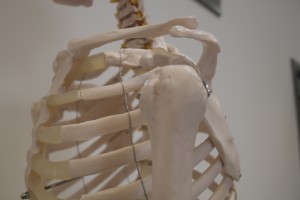Frozen shoulder / Adhesive capsulitis / Humero-scapular peri-arthritis

Rehab training for the injury
Description of frozen shoulder
Humero-scapular peri-arthritis and frozen shoulder are a complex of symptoms that can be defined as diffuse painful shoulder disorder, accompanied by active and passive movement impairment. The term frozen shoulder is poorly understood and has different meanings depending on which structures and tissues are involved in the disorder. Different names used for this disorder include capsulitis, peri-arthritis, peri-capsulitis, stiff shoulder, shoulder / hand syndrome, shoulder component and humero-scapular peri-arthritis.
Any pain in the shoulder can initially give rise to a stiff shoulder, but a frozen shoulder most often occurs when the shoulder is also not used, in conjunction with the person being a nervous type personality with a low pain threshold. In frozen shoulder there will be diffuse tenderness and restricted passive movement.
Symptoms of frozen shoulder
- Initially pain is subtle and may disappear when the patient starts moving.
- Later more intensive pain.
- Disturbed night sleep due to intense nightly pain located deep in the shoulder.
- Radiating pain in the arm.
- Muscular locking of the entire shoulder complex.
- Reduced mobility. First outward rotation ⇒ exit ⇒ forwarding.
- RC atrophy. (diminished stability muscles in the shoulder).
- The pain disappears to some degree when the arm is kept still in inwards rotation alongside the body.
Examinations for frozen shoulder
- Analysis / inspection / palpation / movement test.
- Test of shoulder stability muscles.
- Scapulohumeral rhythm. (shoulder blade – upper arm rhythm.)
- Ask about diseases such as diabetes / bile and heart problems (these will give referred pain in the shoulder but free movement).
Treatment for frozen shoulder
- Rest (immobilize) for the acute stage approx. 7 – 10 days.
- Preparation of treatment plan in collaboration between the therapist and the patient.
- Set for goals that can be reached.
- Sigt efter bevægelighed i skulderen.
- Massage af hele øvre ryg – skulder og arm.
- Thermal treatment (heat).
- Mental Therapy. Make it clear to the patient that cooperation is required to achieve positive results. A little soreness will be present during the therapy etc.
Phases of a frozen shoulder:
- 10 – 36 weeks there will be pain.
- 4 to 12 months there will be stiffness.
- 6 months – 2 years will be improved.
Rehab training for the injury
Here are some exercises that can help to increase movement in the shoulder the first weeks-months. Rehab 1.
When the injury allows a rehabilitation course, you can see shoulder rehab here under instable shoulder.

Social Medier